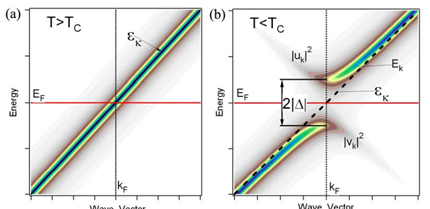Superconductivity is a crucial properties of certain materials which characterized by zero-resistivity and Meissner effect. Below the critical temperature TC, the resistivity will drop to zero abruptly, and inside the superconductor satisfies B=0 regardless of the existence of external magnetic field H. These two properties are essential in observation of superconductivity, and have many important applications such as the superconducting maglev train, superconducting coils, and so on.
In general, superconductors can be divided into conventional superconductors and unconventional superconductors. Conventional superconductors consist of the most metals, compounds and alloys, and it can be interpreted by the BCS theory successfully, which is presented by J. Bardeen, L. Cooper and J. R. Schrieffer in 1957, and they won the Nobel Prize in physics in 1972 for this theory. Based on the assumption of weak coupling, it claims that superconductivity is a novel state of electrons and protected by the superconducting gap \(2\Delta\). In the framework of BCS theory, the superconductivity is a macroscopic quantum coherent effect and arises from the condensation of Cooper pairs. Around the Fermi Surface, the BCS theory argues that with the participation of phonons the electrons with opposite momentum vector (k, -k) will form Cooper pairs. The BCS theory gives a profound understanding of superconductivity, and in great agreement with most experiments.

However, BCS theory cannot explain the unconventional superconductors perfectly. Some novel pairing mechanisms beyond electron-phonon coupling and the strong correlation effect of electrons have been proposed. In 1986, Bednorz and M\(\ddot{u}\)ller found the cooper oxide superconductor, and its critical temperature is about 30 K,after that more and more cooper-based superconductors have been discovered and their critical temperature is higher than McMillan limitation in BCS theory. Nevertheless, in 2006 the Japanese group discovered the first iron-based superconductor, and they have some similar properties as cooper-based superconductors. In general, the high-temperature superconductors have layered structure such as the CuO2 planes in cooper-based superconductors and FeAs or FeSe planes in iron-based superconductors, which is crucial for the existence of superconductivity. Currently, there is not a unified interpretation of high-temperature superconductors. Because of the extraordinary ability of detecting energy dispersions, ARPES is a powerful tool to study high-temperature superconductors.



